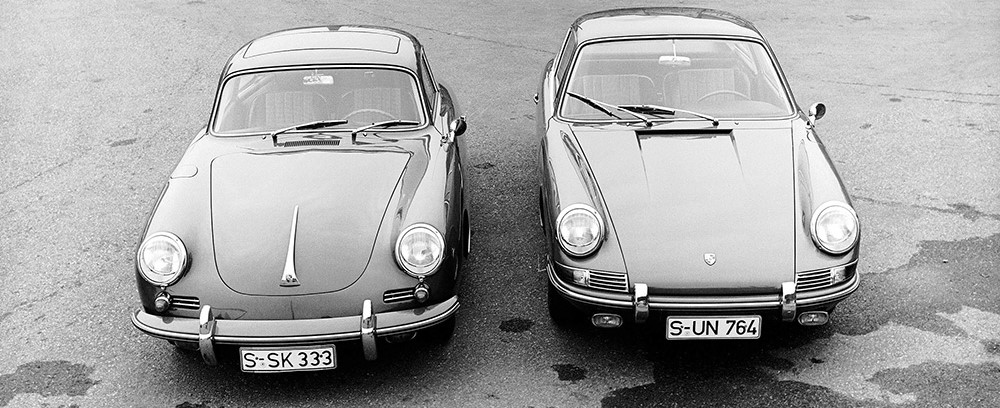
The inception of the Porsche 911
In the world of sports cars, the Porsche 911 has long been viewed as a genuine classic car which combines both modern and traditional elements. This is no great surprise as its family tree can be traced back to legendary forebears such as the Porsche 356 and the Volkswagen Beetle, another Porsche design. It is therefore not by chance that the luggage compartment is at the front and the flat engine is situated at the rear. But precisely because of its venerable genealogy, things were not easy for the Porsche 911 at the beginning. The predecessor model, the 356, was a legend in its own lifetime and the 911 had to measure up to it. As its successor, the 911 was expected to continue the success of the Type 356, 78,000 of which had been sold, but in technical terms it was to be a state-of-the-art car or, even better, ahead of its time. It also had to be larger so that there would still be room for a golf bag in the luggage compartment, despite the 2+2 interior concept.
In line with these requirements, the Porsche engineers created a completely new, bold design – and therefore laid the technical foundations for the resounding success of the car. For example, the frame and the chassis from the 356 were not used for the Type 901, as the design was called internally, but were totally redesigned. To make the luggage compartment more spacious, the designers planned space-saving McPherson suspension at the front and the outdated swing axle was replaced by a semi-trailing arm suspension at the rear.
The launch of the new model was also a great commercial risk for what was then Porsche KG. In 1964, during the production preparation phase, Porsche took over the neighbouring supplier Karosseriewerk Reutter & Co. GmbH. This was a considerable feat for the small sports car manufacturer, as the approximately 1,000 Reutter employees were all taken on by Porsche KG and their years of service were carried over. The fact that Ferry Porsche recognised the potential for the future success of the extremely innovative 911 concept is one of his greatest achievements
How the 911 got its name
When deciding on the name for the new model, Porsche initially based their choice on the Volkswagen spare part number ranges. In view of possible future cooperation with the VW plant, the new Porsche was to be compatible with the number ranges used there. As the 900 numbers had not yet been allocated in Wolfsburg, the decision-makers at Zuffenhausen chose 901 for the six-cylinder version and 902 for a subsequent four-cylinder car. On 12th September 1963 the great day had arrived – Porsche presented the prototype of the 901 at the International Motor Show (IAA) in Frankfurt/Main. However, there was still a long way to go before the vehicle was ready for series production and another year passed until the Porsche engineers had developed the 901 from the prototype phase to series production. The car was then launched on the market in October 1964.
In September 1964, the Porsche 901 was presented at the very important Paris Motor Show. However, the show caused an unexpected problem for Porsche. At the beginning of October 1964, the astonished Porsche management received an objection from the French manufacturer Peugeot which indicated that the type name 901 was in violation of French copyright and trademark protection laws. This initially caused bemusement all round as the model name that Porsche traditionally based on the relevant design number had, in the case of the Type 901 as well, been rigorously researched by the development department. Just one German lorry producer used the name 901, which was not viewed as a problem for Porsche. But Peugeot stated that they had been using three-digit numbers with a zero in the middle since 1929 and therefore owned the legal rights to all similar number sequences in France.
There was nothing left for Porsche to do than rename the 901 right in the middle of the model launch phase. On 22nd November 1964, after considering many different options including using an affix such as “GT”, Ferry Porsche decided to rename the vehicle “Type 911”. The decision was based on very practical considerations. Brochures, price lists and manuals as well as the type number on the rear and on the glove compartment lid were already being finalised, meaning that using the typeface already created for the number “1” twice was the simplest solution. There was just not enough time to create a new number, let alone completely new lettering. In 1964, no one could have guessed that this 911 emergency solution would one day become world-famous.

You must be logged in to post a comment.